Mount Athos Monasteries
Byzantine Heritage
The monastic republic of Athos is an autonomous (self-governing) but not a sovereign (independent) state. The state of Greece has been the protective power of the Theocratic Republic of Athos since 1923. It takes over both border protection and police functions for the Holy Mountain and also grants Greek citizenship to any monk from abroad who enters one of the Athos monasteries.
It should be said that not only monks and novices live on Athos. Many other Greeks also live in the republic. For example, the taverns from Dafni, doctors, pharmacists, construction and forestry workers.
The Greek post office, the telephone company OTE and the electricity provider DEI also have employees stationed on the Athos.
The entry requirements for the monastic republic are extremely strict. Only men get access. Women are forbidden to enter Mount Athos, even when it comes to female animals. The only female beings on the Holy Mountain are chickens because some monks need fresh egg yolk for icon painting.
Mount Athos is a region in which people have lived and died for more than 1,000 years but have not been born. There are no orders (e.g. Benedictines or Franciscans of the Catholic Church) in the Orthodox religion. In this way, virtually all monasteries adhere to the basic rules of the early Christian father of the church, Basilios of Caesarea, but also their own traditions.
Life on Mount Athos
All people on Holy Mountain must adhere to the so-called Kinovetic principle. This includes a vow of poverty, chastity, and obedience to the abbot. All meals are taken together and fasting rules are strictly observed.
With this principle, the monks keep their private property, but must also take care of themselves.
About 2,000 monks on the Holy Mountain currently live according to the Julian calendar, which “lags behind” Gregorian for 13 days.
At sunrise, the day hours start from 12 a.m. to 12 p.m., at sunset, the night hours also from 1 p.m. to midnight. As the sun rises and sets regularly, the time changes every 4 days. The monks attend church services for at least 8 hours a day, up to 14 hours on public holidays.
They spend a further 8 hours at work, which primarily serves to supply the monastic communities themselves and the pilgrims. This includes agriculture, fishing, kitchen service as well as gardening and cleaning work. Other works include icon painting, wood carving, book restoration and of course calligraphy. Candles are also produced for liturgical purposes. Administrative work and art renovations are done daily.
Life on Mount Athos usually takes place in one of the 20 monasteries, some of which also have smaller skites and cellars. Although there are occasionally hermits and ascetics who live alone in hermitages, small huts or even caves, which are hidden somewhere in the mountains of Athos. There they try to live in the strictest monastic asceticism.
The distribution of tasks in the monasteries is hierarchical. At the top is the head of the monastery, the abbot, who is supported by a council of elders, but is solely in charge. Each monastery also sends an Antiprosopos (a representative) elected for one year to the administrative capital of Athos, Caries.
The Iera Kinotis, the Holy Community, which is the supreme organ of the monastic republic, meets there three times a week. The Iera Kinotis is also responsible for relations with the Greek government and the ecumenical patriarchy in Istanbul.
When monks die, their corpses are buried without a coffin – only clothed with their cowls. The graves mark simple wooden crosses. After three years, the remains are exhumed and the skulls washed out with wine. If these are white after the procedure, the souls of the deceased are considered sacred.
Throughout its history, the Holy Mountain was able to maintain a status that was more or less independent. In any case, the Holy Mountain understood and sees itself as one of the most important centers of the Orthodox faith. Unfortunately, the history of the monks’ republic, which spans more than 1,000 years, might be over in the not too distant future.
Because the monasteries have complained for years about the lack of offspring, although the number of fellow believers is currently increasing again. Many complexes of the monasteries are orphaned and deteriorate as a result. If the number of monks in a monastery is reduced to less than 6, the state of Greece has the right to take over the monastery itself.
Since this could then be the first step towards tourism in Athos, it is certainly not only a possible idea due to the maintenance costs that this entails.
“ When I understood that neither parents, nor family, nor friends, nor anyone in the world could offer me anything but pain, insults and wounds, I resolved to stop living for the world.“
Elder Thaddeus of Vitovnica Tweet
Orthodoxy
The word orthodox refers to the contrast between Eastern Orthodox and Roman Catholic denominations. The church in the west became increasingly political after the Western Roman Empire collapsed. And the Bishop of Rome finally declared himself the only representative of God on earth. This interpretation met with little understanding, especially in the areas of the Eastern Roman or Byzantine Empire. The missionary work of the Slavs, not least due to the introduction of the (Cyrillic) script, made Constantinople the center of Eastern Christianity. The Pope and the Patriarch of Constantinople (formerly Byzantium, now Istanbul) excommunicated each other in 1054. This measure was abolished at the Second Vatican Council in 1965.
Monasteries
The monasteries have almost the same basic architecture. The outer complexes are mostly built like fortresses, often even with defense towers, bridges and battlements. In the past, this has often – but unfortunately not always – been successful in defending against pirate attacks. The structure of the monasteries is usually rectangular. Outside the defensive walls, inside the courtyards with the monastery churches, which always have a cross dome. In between are the common rooms and monks’ cells.
Anyone who intends to visit a monastery or even spend the night there is well advised to register by phone beforehand. Because occasionally visitors do not fit the monks at all at certain times, or the guest beds are already fully occupied. The area code for the Athos is 0377, the phone numbers of the monasteries are given in the descriptions.
In the following, the monasteries are not listed alphabetically, but according to the hierarchical order of 1 to 20 common in the monastic republic. This has remained unchanged since the 16th century and was confirmed by the so-called Typicon of 1783.
Great Lavra
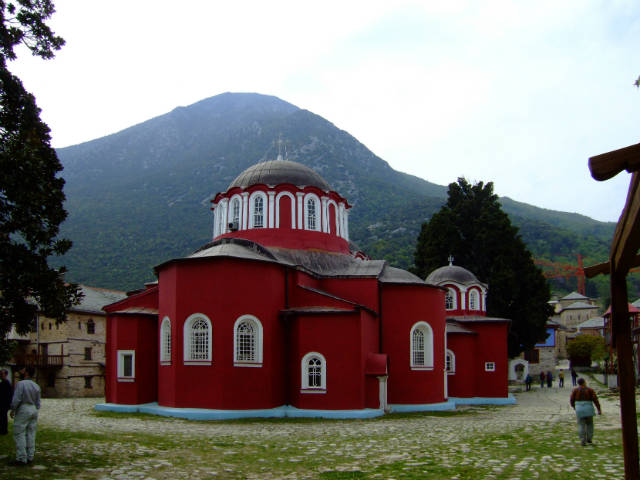
Great Lavra
The monastery, founded in 963, is not only the oldest on Athos, but also the most famous and the most respected one.
It is located at a height of 150 meters on a natural rock plateau on the southeast coast and therefore directly at the foot of Mount Athos.
Its construction is somehow medieval because the monastery has all sorts of towers and defensive walls. The fortress wall once had 15 defensive towers, today there are nine. Among them the “Tower of Tzimiskes”, the name of which goes back to the Byzantine emperor Ioannes Tzimiskes (969-976). The founder, the monk Othios Athanasios (also: Athanasios Athonites), is said to have died in the construction of the monastery church.
The monks of the monastery then buried Athanasios in the Katholikon. His grave is in the northern chapel dedicated to the 40 martyrs. The monastery itself, which Athanasios originally dedicated to the proclamation of Mary, was probably dedicated to Athanasios’ decease in the 15th century.
The walls of the monastery rooms are partly decorated with magnificent paintings by Theophanes from 1535 and Phrangos Katelanos from 1560. In the Katholikon, the most beautiful and important monastery church of Athos, there are frescoes from 1535, which were painted in the Cretan style. Almost 2,500 historically valuable manuscripts, books, and other documents are kept in the monastery library.
The monastery also houses valuable priestly robes and the crown of the Byzantine emperor Nikephoros I. Phokas († 969).
The skites Agias Anna, Kavsokalyvia and Timiu Prodromu are subordinate to the monastery.
Monastery Vatopediou
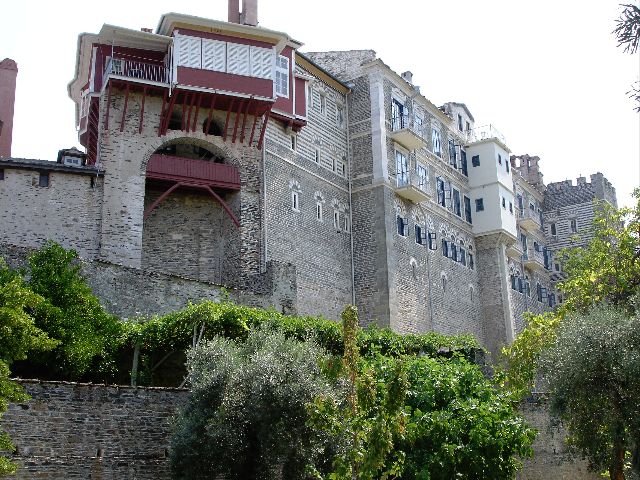
Vatopediou
The largest monastery in the monastic republic was founded between 972 and 985. This is clear from the fact that it is not mentioned in the first typography in 972, but is first listed in writing in a document by Protos Thomas from 985.
The monastery probably got its name from the two parts of the word “vatos” (blackberry bush) and “pedion” (plain). Because its location is actually on a level that is overgrown with numerous blackberry bushes. In the second Typikon of Athos from 1045, it was listed in second place in the hierarchy of the monasteries. It retains this position until today. Accordingly, it must have been of great importance in those years, as it was temporarily inhabited by up to 300 monks. It is dedicated to the Annunciation.
It lies on the east coast and impresses with a defense tower with battlements and an almost 200-meter long waterfront of the triangular complex, which somehow reminds of a medieval town. Not much is known about the founder. There is, however, a mosaic with an inscription in the catholic icon, which Hegumenos (abbot) Ioannikios of Vatopedi names as the founder. In fact, an abbot with this name is said to have traveled to Emperor Alexios I. Komnenos (1081-1118). That Ioannikios is probably the builder of the monastery church, but not the founder of the monastery.
The monastery is home to an extremely valuable treasure, around 2,000 old manuscripts as well as around 10,000 valuable books and almost 30,000 other printing units.
In addition to monumental mosaics from the 11th and 12th centuries, frescoes from the 14th and 15th centuries can also be admired in the monastery church. One of the most important relics of Athos is also kept in a chapel with the belt of Our Lady. The treasury also contains a piece of the reed with which the crucified Jesus was given the sponge soaked in vinegar.
Incidentally, here – as is usual on Athos – you do not use the Julian calendar, but the Gregorian calendar.
The skites Agiu Andreu and Agiu Dimitriu are subordinate to the monastery.
Iviron Monastery
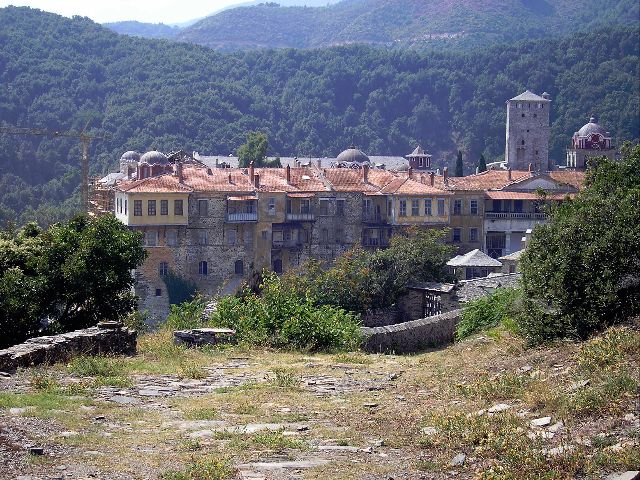
Iviron
The monastery is closest to the capital Caries. It is in a wonderful location right on the east coast. It is dedicated to the Dormition of the Blessed Mother.
Its foundation around 980 goes back to Ioannes Tornikios. He was a dignitary at the court of the Georgian Prince David of Tao before he went to the Holy Mountain, where he met Athanasios Athonites. In 978 he successfully carried out a diplomatic mission for the Byzantine emperor Basileios II (976-1025). He received a privilege certificate and funds from the emperor, which enabled him to build the monastery.
Initially brought to wealth and prosperity from home by Georgian monks and their patrons, the monastery attracted more and more Greek fellow believers. In the 14th century, the Greeks outnumbered the Georgians. Today the monastery is completely inhabited by Greek monks after the last Georgian died in 1955.
The monastery is home to an extremely valuable treasure, which is widely regarded as the most important library of Athos. These are numerous manuscripts from the 13th century as well as irreplaceable Venetian first prints of Greek classics from the 15th century. This collection was saved in 1865 when the monastery was burned to the ground.
Numerous relics are kept in the treasury. Among them the right hand of the church father Basilios of Caesarea (the great), the head of Gregory of Nyssa as well as various communion chalices and crosses. The Portaissa chapel also contains some interesting 17th-century frescoes. These show some people from pagan antiquity, who is portrayed as particularly wise and secular predecessors of Christianity. Among them are Alexander the Great, Aristotle, Darius, Plato, Sophocles and Thucydides. Also at the entrance to the chapel dedicated to the Blessed Mother is one of the most important icons of Athos: the Panagia Portaissa, the “Blessed Mother of the Gate”.
Legend says that Emperor Theophilos (829-842) escaped the rage of destruction by being thrown into the sea near Constantinople and washed up on the beach of Athos. The monk Gabriel had the divine vision of bringing the icon ashore and bringing it to the holiest of saints in the monastery church. But from there icon disappeared three times as if by magic and found herself at the entrance to the church.
Ultimately, the monks were tired of bringing icon back again and again, so that it is still at the gate to the chapel today. Especially since a divine voice spoke to them for the image of grace: “I am here to guard you, not to guard me.
The skite Timiu Prodromu reports to the monastery.
Monastery Chilandariou
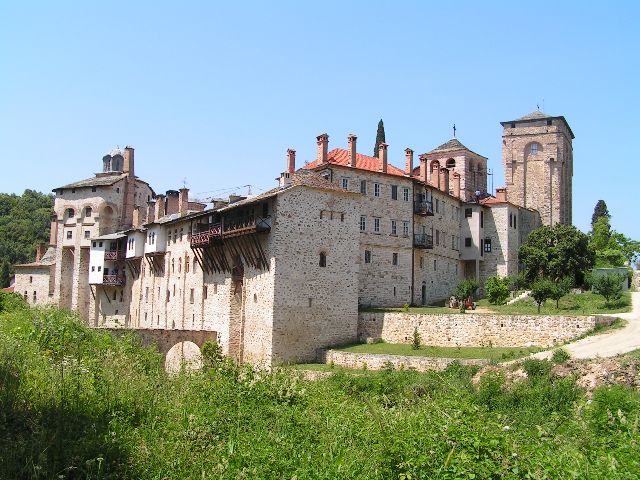
Chilandariou
The monastery, founded around 1197, is closest to the land border that separates the monastic republic from the secular part of the peninsula. It lies like a fortress in a densely forested basin and is dedicated to the Virgin Mary.
Rastko, a son of the Serbian grand priest Stefan I. Nemanja, is considered the founder. He had secretly gone to Mount Athos to live as monk Sava, first in the Panteleimonos monastery, then in the Vatopedi monastery. In 1197 his father followed him to the Holy Mountain. Together they wanted to found their own monastery, for which Vatopedi provided them with dilapidated walls in the north of the peninsula.
These were the remains of a monastery founded by Georgios Chelantaris around 1000. This was mentioned for the first time in 1015. The two noble monks have now built their new monastery on its foundations, which should keep the name of the original until today.
Savas later left Athos and became the first independent Archbishop of the Serbs around 1220 and is therefore considered the founder of Serbian church independence. The monastery, on the other hand, received steady donations from home over the following centuries, which strengthened its position as the center of Serbian Orthodox piety.
It houses a collection of old icons, a magnificent altar book and various valuable crystal vessels, all from the 14th century. The monastery church is decorated with frescoes from 1320 and in the refectory, you can see the murals that date from 1623 and were designed in Serbian style.
In 1722, around two thirds of the monastery buildings were destroyed by the flames. Another major fire destroyed large parts of the plant in 1891. But in 1896 King Alexander I, the first ruler of the new Kingdom of Serbia, made his way to the monastery, with the result that funds and Serbian monks were responsible for the reconstruction.
Monastery Dionysiou
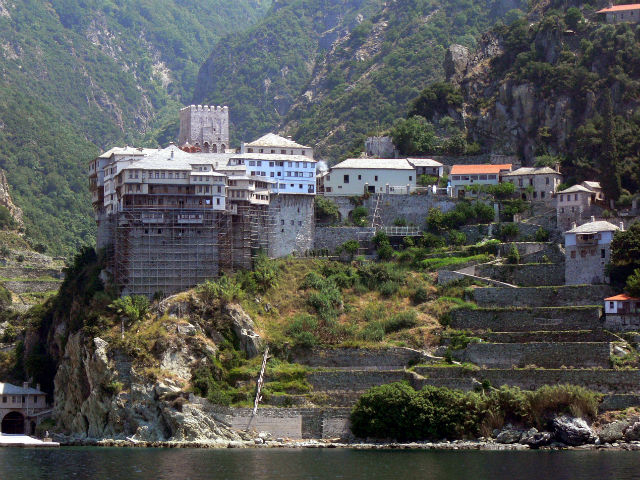
Dionysiou
The monastery is dedicated to the birth of St. John Baptist. It was founded in 1366 by the monk Dionysios based on a divine vision initially as a small monk settlement due to a lack of funds.
Later when the Byzantine emperor was convinced of the need for a large monastery, the construction of the complex began. It has held fifth place in the monastery hierarchy since 1574. In the third typicon of Athos from 1394, it was listed in the fourteenth place, at that time there were still 25 monasteries on the Holy Mountain.
The monastery houses the “Golden Bull” of Emperor Alexios III. Komnenos, which contains the monastery foundation of 1374. The library also has around 1,000 other manuscripts and more than 5,000 printed publications.
Also noteworthy are Cretan-style frescoes from 1546 and 1547. These are located in the monastery church and the refectory. Including world-famous motifs such as that of the Apocalypse. After the fall of the Byzantine Empire, the monastery was supported by the princes of Moldova and Wallachia. The 25-meter-high defense tower built-in 1520, which has been preserved to this day, dates from this period.
A fire destroyed almost the entire monastery in 1535. Except for the defensive tower mentioned and the foundations of the Catholic icon, there was not much left. Grand Prince Peter IV (1527-1546) had the monastery rebuilt.
The monks were able to save one of the most important icons of Mary from the fire. It is said to be a picture of grace painted by the evangelist Luke, which Patriarch Sergios wore around Constantinople in 626 to keep the Avars away from the city.
Monastery Koutloumousiou
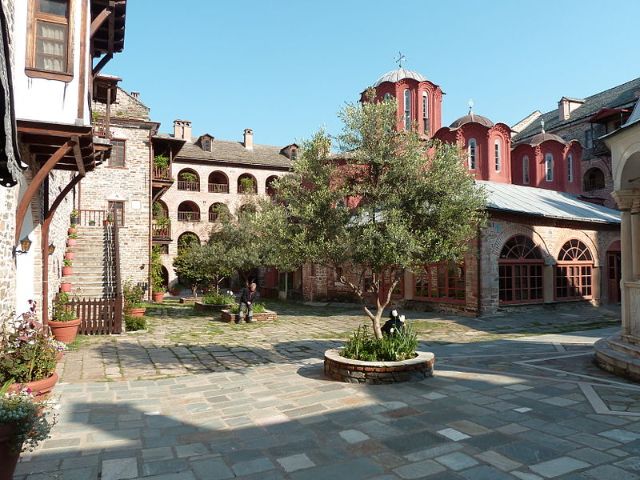
Koutloumousiou
This monastery was probably founded around 1150, although it is not entirely certain who was responsible for it. In any case, the Greeks assume that it was an African monk because the name Koutloumous means something like "the saint from Ethiopia".
The other possibility would be that a member of the Seljuk-Turkish princely family Kutlumus founded the monastery. Because it is mentioned for the first time in a document from 1169, which was signed by a certain “Isaias, monk and abbot of the Kutlumusi monastery”. So, it can be assumed that the monastery is named after him. The monastery is dedicated to the Transfiguration of Christ. It has been sixth in the monastery hierarchy since 1574.
However, the monastery fell into disrepair later. It was temporarily placed under the Dionysiou monastery until it received new donations in 1625 from Alexander Radul, Prince of Wallach, and subsequently from Romanian princes. In 1857 and 1870, the monastery fell victim to two major fires that only spared the Katholikon and the library.
Nevertheless, a magnificent wood-carved temple and numerous wall paintings from the 16th century have been preserved. In the monastery church, there is an interesting cycle of frescoes from the 18th century, which represents “the whole spirit world praise the Lord” with goblins, a unicorn, and even a bare-breasted female centaur.
The Skite Panteleimonos is subordinate to the monastery.
Monastery Pantokratoros
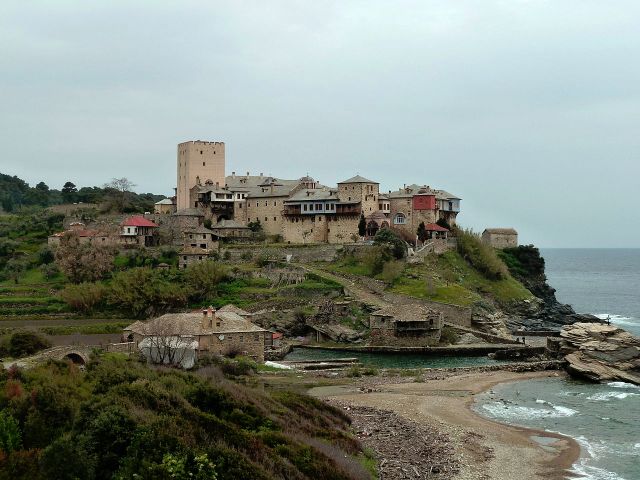
Pantokratoros
The brothers Alexios (who was involved in the reconquest of Constantinople under the Byzantine emperor Michael VIII) and Ioannes Strategopoulos founded this monastery in the 14th century, before 1358.
They built the monastery on the site of an abandoned Kellie in honor of the Christ Pantocrator, the “all-ruler” (Christ). Probably in 1362 or 1363, it was dedicated to the Transfiguration of Christ. At least one stone tablet in the bell tower dates from August 1363, which contains the names of the two donors as an inscription.
The founding brothers themselves were never monks in their monastery, but they bequeathed real estate and wealth to it during their lifetime, so that it quickly counted as a large monastery. Since the typicon of 1574, it has taken seventh place in the monastery hierarchy of Athos.
However, numerous fires repeatedly hit the monastery building. For the first time, the complex fell victim to the flames in 1392, the last one burned in 1948. Nevertheless, the Katholikon, the main defense tower and some parts of the monastery wall have been preserved from the time of its foundation.
Inside, it not only houses around 400 old manuscripts and almost 3,500 books but also relics as the right foot and a leg of the apostle Andreas. The graves of the two founders of the monastery are also in the Katholikon.
The skite Profitis Ilias (the prophet Elijah) is subordinate to the monastery.
Monastery Xiropotamou
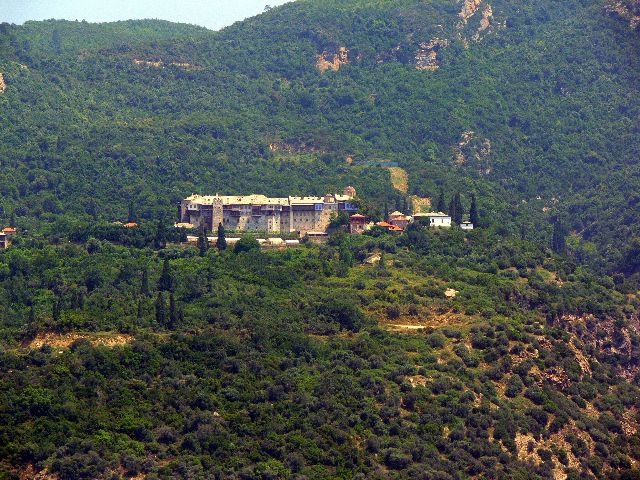
Xiropotamou
According to legend, the monastery was founded in the 5th century by the virgin Poulcheria, daughter of the emperor Arkadios.
According to another tradition, its founder in the 9th century was the Blessed Pavlos Xeropotamenos, who opposed Saint Athanasios and probably wanted to offer an alternative to the Megistis Lavra monastery. The most important relic of the monastery, consecrated to the 40 martyrs, is said to date from that time: A splinter of the cross of Christ, which Pavlos 933 (!?) Is said to have received from Emperor Romanos I.
The proven history of the monastery dates back to the 10th century. In a document, a monastery is associated with the year 956, which was consecrated to Saint Nikephoros and had the addition “tu Xeropotamu”. However, at the end of the 10th century, the Agiou Pavlos monastery was also called “tu Xeropotamu”.
In its early days, the monastery only appeared to have played a minor role on Mount Athos. At the end of the 11th century, however, documents attested to a significant increase in his wealth, which lasted until 1309.
In the 16th and 17th centuries, the monastery, which is located on the waterfront near the road from Dafni to Karies, was repeatedly the victim of pirate attacks, which is obviously due to the construction, which is less like a fortress but more like a large Venetian villa.
The monastery became increasingly impoverished during the Turkish rule.
But it should also testify to the authenticity of the cross splinter they so much admired. The monks not only traveled with the relic to the surrounding area but even to Russia to ask for alms for their monastery. Convinced of the authenticity of the splinter from the cross of Christ, the money of the faithful flowed.
Unfortunately, the monastery was hit several times by devastating fires in 1280, 1507, 1609 and 1974. Due to the fire, no monastery buildings could be preserved from the founding period. The oldest parts of the building of today’s facility date from the 18th century.
Monastery Zografou
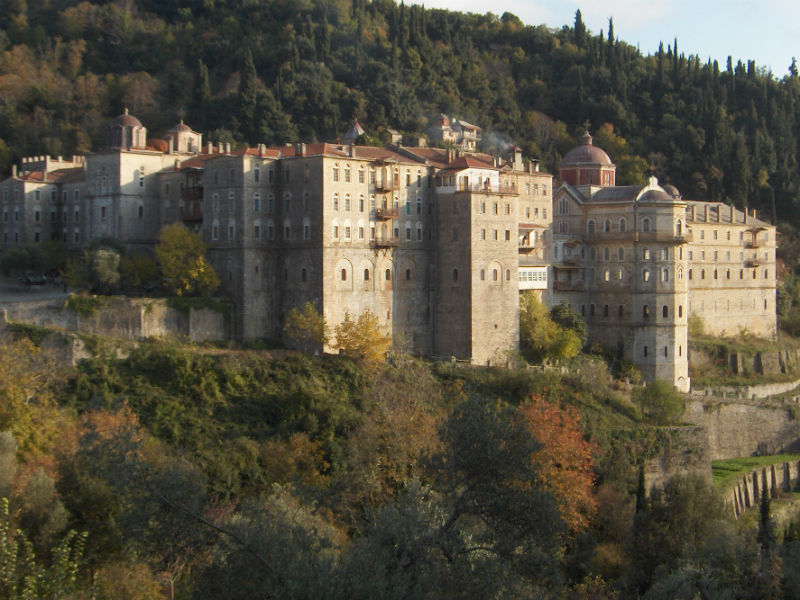
Zografou
According to tradition, the monastery was founded by the Byzantine Emperor Leon VI. († 912), the Bulgarian tsar Ivan Asen II († 1241), the Serbian Tsar Stefan Dusan († 1355) and the Serbian despot Jovan Ugljesa († 1371).
The situation is similar to another legend about the construction of the monastery. It is said that it was founded in the 10th century by the brothers Aaron, Johannes and Moses from Ohrid. Because they could not agree on whom to consecrate, they put up a wooden plate and asked for a divine sign.
The next day, on the blackboard, was the face of Saint George, to whom they dedicated monastery. And they named their monastery after the unknown artist: “Zografou” (the painter). However, it can be seen from documents that in 972 a monk named Georgios signed the first typicon of Athos.
It can, therefore, be assumed that Georgios, who was a painter, was not yet the abbot of a monastery at this time, but that a monastic community had first been formed around him. This is also attested by another document that mentions such a community for the year 980.
It can be concluded that the monastery was named after the profession of the founder and was consecrated to St. George according to his name. At first, only inhabited by Greek monks, Bulgarian monks probably only gained the majority in the monastery in the 13th and 14th centuries.
It lies in the northern inland of the peninsula and is now almost exclusively inhabited by older monks. Unfortunately, the monastery has been the victim of fires several times over the centuries, so that none of the original buildings have survived. The current facility dates from the complete reconstruction in the 19th century.
Monastery Dochiariou
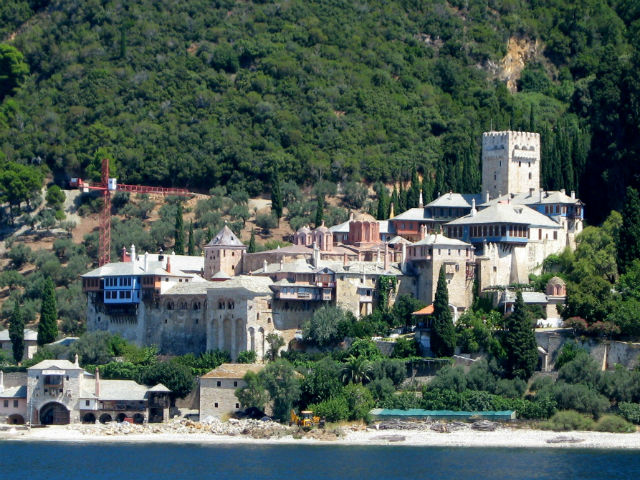
Dochiariou
According to tradition, the monastery is said to have been founded around 950 by Evthimios, a student of Saint Athanasios. However, this cannot be proven historically.
In ancient documents, the northernmost monastery on the west coast was first mentioned around 1030. It is believed that it was founded before 1013. by a monk known as “Docheiarios” (accounting officer).
Another document from 1037 mentions a monastery that was dedicated to St. Nicholas of Myra, called Dafni and called “tu Docheiariu”. Because initially the monastery was located near the port of Dafni. Between 1083 and 1108 the monastery was moved from its original location to its current location. Since then it has been dedicated to the Archangels Michael and Gabriel.
Under Abbot Neophytos, a wall with a defense tower was built around the monastery and the Katholikon was expanded. In 1568 the monastery complex was renewed and expanded on a large scale by the Romanian prince Alexander IV Lapusneanu.
From the 14th and 15th centuries, the monastery houses some privileges from Byzantine emperors.
Within the monastery church consecrated in 1568, it also contains the richest and best-preserved fresco jewelry on Mount Athos. Unfortunately, there is a strict photography ban in the monastery!
Monastery Karakalou
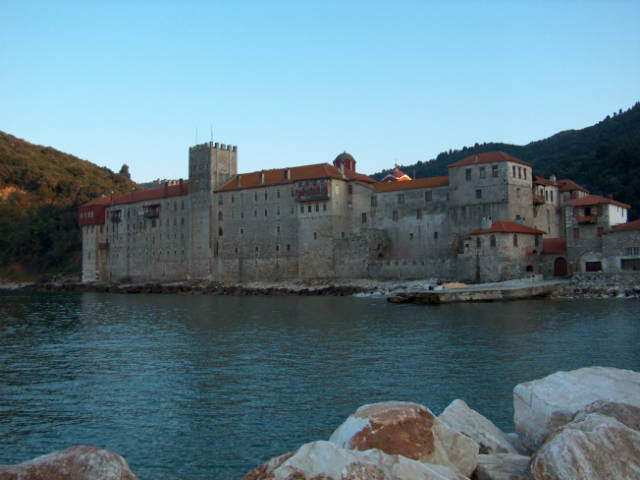
Karakalou
Its foundation goes back to the Roman Emperor Caracalla (211-217). The monastery appears for the first time in a document by Protos Nikephoros from 1018. This makes it one of the oldest foundations of the monastery on Athos.
Some sources assume that a monk named Karakalas founded this monastery in the 11th century.
It is located off the coast on the eastern half of the peninsula and is dedicated to the Apostles Peter and Paul. The monastery does not seem to have gained any great importance in its history. Because there are only about 150 manuscripts and almost 2,500 books in the library there.
The small number of documents, manuscripts and books can also be due to another circumstance. Because Lord Robert Curzon also visited the Karakalou Monastery on one of his trips between 1834 and 1837. There he went with the abbot to the library, which was in terrible condition.
He asked the abbot for some writings and books that he wanted to take with him. The abbot had absolutely nothing against it. Today, those are kept in the British Library in London. Obviously, this monastery was much larger in the past than today.
The monastery was extensively renovated at the time of the Moldavian Prince Peter IV Rares (1527-1538 / 1541-1546). The imposing tower, which towers over the entire complex, dates from that time. The monastery church and the wall paintings contained therein, however, date from the 18th century.
Monastery Philotheou
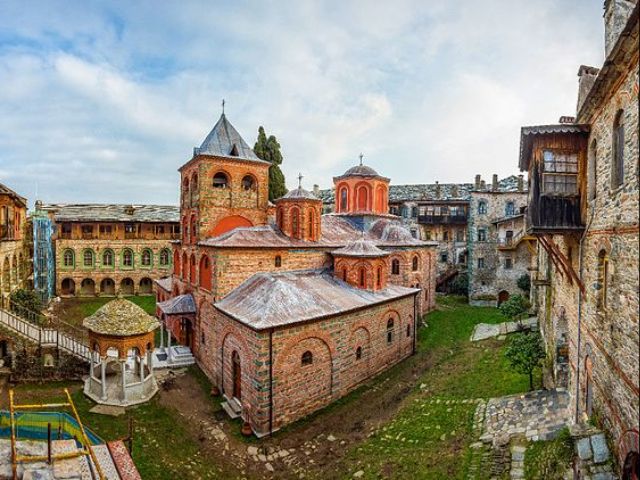
Philotheou
The monastery is located at an altitude of 533 meters on the eastern foothills, south of the capital Caries. It is framed by a thick chestnut forest. It is dedicated to the Annunciation.
Almost nothing is known about its foundation. Mention was made in a document from 1015 and in a document from 1021. While it had no special significance on the Holy Mountain in the first two centuries of its existence, this changed in the 14th century. At that time, it found patrons from the emperor’s house and later among the princes of Serbia. The consequence was the influx of Serbian and Bulgarian monks in quite large numbers. In the 16th century, almost the entire monastery complex was destroyed by fire. Even after that, it was repeatedly the victim of the fire. Another fire occurred in 1871.
Except for the refectory from the 16th century, the Katholikon from 1746 and the library, almost the entire monastery was again destroyed. Most of today’s buildings date from the 18th century. The greatest treasure of the monastery is the icon Glykophilusa, a representation of the Virgin Mary holding the baby Jesus in her arms and kissing it. This portrait is one of the oldest on Mount Athos. And there is a legend: the icon is said to have once belonged to a patrician named Victoria, who lived in Constantinople.
She came to the coast of Athos, where she found the abbot of the Philotheo monastery. At the point where the portrait reached the beach of the Holy Mountain, a spring opened up, the healing waters of which helped childless women and the paralyzed for centuries.
Monastery Simonos Petras
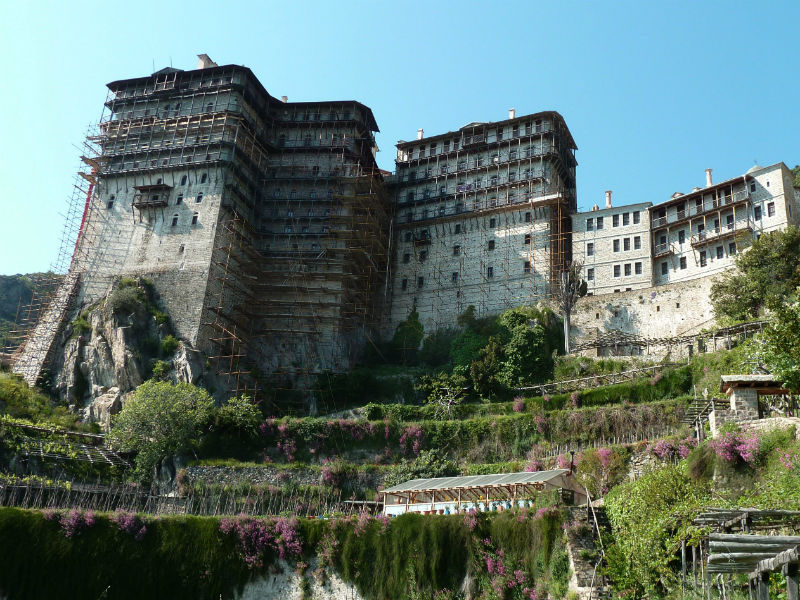
Simonos Petras
The large monastery, dedicated to the birth of Christ, is somehow reminiscent of Tibetan Lama monasteries due to its construction. It lies at a height of more than 200 meters on a rather steep cliff that completely surrounds it.
The building has ten floors with a total height of around 40 meters. According to legend, the founder was Blessed Simon, who once lived as an ascetic on the Petra (Greek: rock) on which the monastery was later built. When a miraculous light illuminated the rock cone, he interpreted this as a sign to found a monastery here.
Simon called it Nea Vitleem (New Bethlehem). The monastery was first mentioned around 1345. The exact date of foundation is unknown, but 1284 is often mentioned. As for the naming, it seems to have been based on the tradition of Simon on the rock. The Serbian despot Jovan Ugljesa could have been the founder.
At least the monastery received extensive donations from him in 1364. At the end of the 14th century, it was one of the 25 large monasteries at the time. In 1580 the monastery was completely destroyed by a major fire. It is assumed that all documents, manuscripts, books, relics and other treasures that have existed up to that point have been destroyed.
It was rebuilt by the Romanian prince Michael the Brave. But in 1626 it was again destroyed by fire. Donors were also found afterward that made a new building possible.
After that, the monks of the monastery were able to enjoy their prosperity for around two centuries, until it became less important in the middle of the 18th century due to economic problems and political unrest. On June 28, 1891, the imposing monastery was again hit by a large fire.
The entire complex was destroyed again. The monks were able to get to safety with the relics they worshiped, but all the other treasures of the monastery were once again destroyed. These include around 250 very valuable manuscripts. But again, this time it was largely restored according to old plans.
Monastery Agiou Pavlou
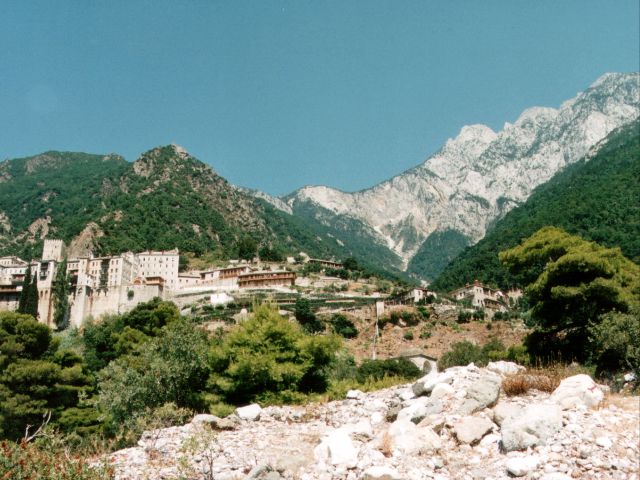
Agiou Pavlou
The monastery dedicated to the Virgin Mary is located in the south of the west coast and was built close to the summit of Mount Athos and its foothills.
The period of its foundation is uncertain but is believed to be in the 10th century. A connection is made with a monk named Paulos. Originally it was probably a skite of the Xiropotamou monastery.
Around 1360, two Serbian monks from Xiropotamou Monastery were able to acquire these skites. And as early as 1394 it was counted among the 25 large monasteries existing at the time. Various documents by Byzantine emperors and Serbian princes confirm the importance of the monastery in the 14th century.
The Slavic influence remained for several centuries. This can be seen, among other things, from the fact that the abbots of the monastery still wrote their Slavic script in the 15th and 16th centuries. Even around 1700, there is evidence that the monastery was home to both Slavic and Greek monks.
During the Greek Civil War (1821-1830) the monks left their monastery, whereupon it fell into disrepair. In 1840, Greek monks took over the ruins and rebuilt the monastery.
In 1902, the newly built monastery was hit by a devastating fire. Monks went back to work and rebuilt what was destroyed. Because of this relatively recent building history, the monastery now functions as a relatively modern but powerful fortress.
In addition to almost 500 valuable writings and more than 12,000 old books, the monastery also houses by far the most valuable treasure of all Athos monasteries, the myrrh grains, which were given to the baby Jesus by the three wise men. Also interesting are frescoes from 1423 with which the chapel of Agios Georgios is decorated.
The skites Agiou Dimitriou (Lakkou), Agiou Spiridon, and Kalibes Agiou Paulou are subordinate to the monastery.
Monastery Stavronikita
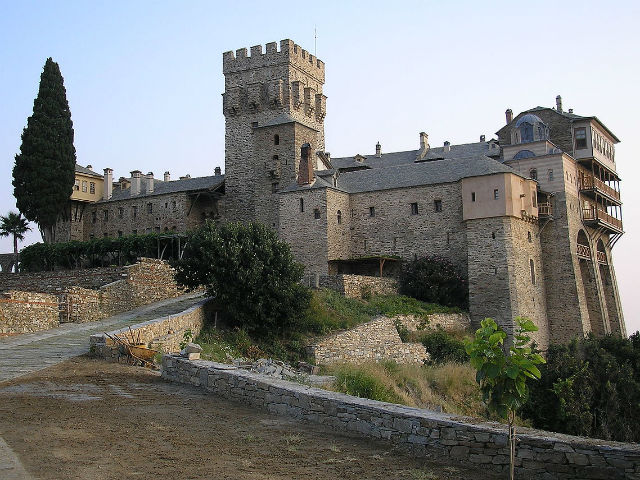
Stavronikita
The smallest of the 20 Athos monasteries today looks more like a knight's castle from Franconia. So, the construction of the buildings is quite close together and the defense tower has a few battlements.
Exactly when and above all by whom the monastery was founded cannot be proven. According to legend, the founders were the monks Stavros and Nikitas, who previously lived as hermits on Mount Athos. Another pious story mentions an officer named Nikephoros Stavroniketas, who is said to have served under the Byzantine emperor Ioannes Tzimiskes.
Various writings show that it must have existed between 1020 and 1030 as a smaller monastery. In 1153 it appeared under its old name “Stravoniketas” (squinting Niketas). At what point it was renamed “Stavroniketas” (winner of the cross) is unknown.
Before 1287 it must have lost its importance. Because this year it will be subordinated to the monastery Koutloumousiou, later to the monastery Philotheo.
In June 1533, a monk named Gregorios Giromeriatis bought the monastery for 4,000 pieces of silver. He immediately started restoring the complex. When he died, Patriarch Jeremiah I (1522-1546) continued to work, especially since he had previously been the donor. So, the Katholikon was inaugurated on July 3, 1546.
The most valuable treasure of the monastery is a mosaic icon from the 14th century, which hangs on the right choir pillar of the monastery church and represents Saint Nikolaos, to whom it is also dedicated. There are also numerous other murals by the Cretan painter Theophanes in the Katholikon, including a portrait of Jeremiah I, the founder of the monastery.
Unfortunately, the monastery fell victim to severe fires five times within 250 years. Nevertheless, the monks have preserved it to this day and have secured its existence.
Monastery Xenofontos

Xenofontos
The monastery is located on the west coast of the peninsula and was founded around 983. The patron saint was the monk and priest Xenophon, who is mentioned in the saintly life of Athanasios.
So there are still several documents from the years between 998 and 1018 that bear his signature. He signed those documents at the time as “Xenophon, monk, and abbot of the monastery of St. Georgios”. This is the original name of the monastery and it is dedicated to Saint George to this day.
The monastery was first mentioned as a Xenofontos in 1035. His influence on the Holy Mountain increased enormously in the period that followed.
Around 1078 the Grand Admiral Stephanos, who called himself a monk Symeon, entered the monastery. The monastery also benefited from its contacts with the Byzantine emperor. But there was a big scandal about Symeon because he was a eunuch. And such were prohibited from staying on the Holy Mountain.
As the resistance to himself became too great, Symeon left Athos in 1081. In this matter, he was supported by the new Byzantine emperor Alexios I. Komnenos (1081-1118). In 1089 the eunuch received a corresponding privilege certificate from the emperor, which enabled him to become abbot of Xenofontos.
This happened with another scandal because Symeon brought along three “beardless youths” as servants, who were also forbidden to stay on the Athos. But the waves smoothed out because the Protos of Athos at that time was given a rather large sum of money to “overlook” this illegality.
After the 4th crusade in 1204, the monastery had to go through a period of crisis that only came to an end at the beginning to the middle of the 14th century with the help of the emperor. Even in the 15th century, the future of the monastery looked bad. This time patrons from Romania were the saviors, although the monks around 1700 were mainly of Serbian and Bulgarian descent.
Nevertheless, there was another crisis: if the monastery still had 55 monks in 1089, there were only four in 1744.
The new main church of the monastery is the largest one on Athos, was built from 1809 to 1819 and houses two 12th-century mosaic icons depicting Saints Dimitrios and Georgios. The old Katholikon is also still preserved and contains numerous wall paintings by the Cretan painter Antonios from the mid-16th century.
Unfortunately, the monastery fell victim to numerous fires. In the meantime, however, it has been almost completely rebuilt.
By the way, “Deutsche Grammophon” published a CD with liturgical Easter music of the monastery in 1996.
The Skite Evangelismu is subordinate to the monastery.
Monastery Osiou Grigoriou
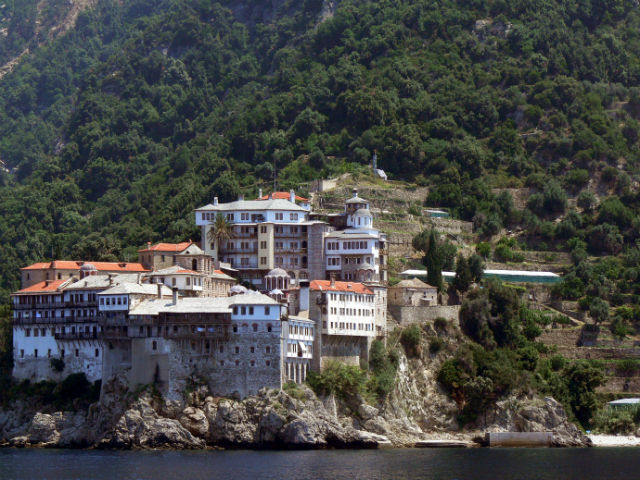
Osiou Grigoriou
The monastery, dedicated to Saint Nikolaos, dates from the 14th century and is therefore relatively young. It is located on the west coast directly on the coast and is one of the smallest on the Athos peninsula.
Considered one of the most colorful monuments of Athos, the monastery was founded either by Saint Gregory the Younger or by his teacher, Gregorios the Sinaite. It is mentioned for the first time in a Typikon from 1347. It is in 22nd place from the then 25 monasteries.
It was not until 1483 that the monastery reappeared in old documents when Abbot Aberkios signed a document in Slavic. At the time, it was said to have housed more than 270 monks. After that, it must have deteriorated at some point before the Romanian Prince Stefan the Great had it rebuilt.
A major fire in 1761 almost destroyed the monastery, as the number of monks dropped rapidly. Nevertheless, it could maintain its existence through Romanian patrons until the 19th century. The north wing of the complex was inaugurated in 1776. The newly built Katholikon followed in 1779 and the south wing of the monastery in 1783.
The monastery complex was more than doubled between 1892 and 1900, as of the end of the 19th century, it experienced a real upswing due to the arrival of the monks.
The monastery church is decorated with wall paintings from the 18th and 19th centuries. There is also an icon that is unusual for Athos, a 500-year-old representation of the nursing Mother of God (Panagia Galaktotrophoussa). The monastery library houses around 300 old manuscripts and around 400 valuable books.
Monastery Esfigmenou
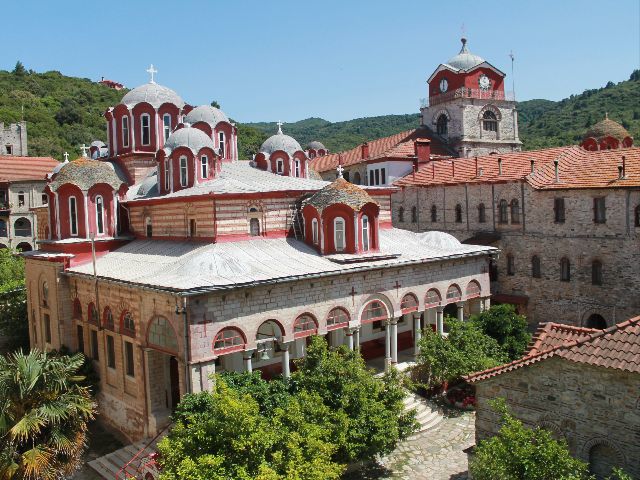
Esfigmenou
When exactly the monastery dedicated to the Ascension of Christ was built is not known. In any case, it is one of the older buildings on the Athos. The year 1016 is mentioned as the year of its foundation.
It is assumed that it was founded at the end of the 10th century. It is said that it was founded by Pulcheria, the sister of Emperor Theodosios II. Another tradition mentions a monk named Esphigmenos, who is considered the founder.
The name of the monastery is also unclear because “esphigmenos” (the constricted) could be attributed, among other things, to its location. The complex, which looks like a castle from the Middle Ages, is constricted by hills right on the beach on the east coast of the Holy Mountain. The first documents dates back to the year 1030.
The Typikon from 1045 lists the monastery in fifteenth place. After that, nothing is known about the further course of the monastery history between 1095 and 1300. The monastery was only mentioned again in the 14th century. From this time on it had gained importance both through the favor of Byzantine emperors and through the contributions of Serbian rulers.
The monastery complex, which is located directly by the sea, was repeatedly the victim of pirates, it was completely robbed by pirates in 1533 and badly damaged. At the beginning of the 17th century, the monastery was initially abandoned until it was used by monks for a short time between 1634 and 1655.
At the beginning of the 18th century, it experienced a revival, which, however, should take less than 50 years due to high debts. It was only around 1800 that the monks were able to master the situation again.
A copy of the “Painter’s Guide from Mount Athos” was discovered in the monastery in the 19th century. It is an extremely important source of relevant guidelines that the painting monks have to adhere to, but it also serves to gain a general understanding of icon painting.
Monastery Agiou Panteleimonos
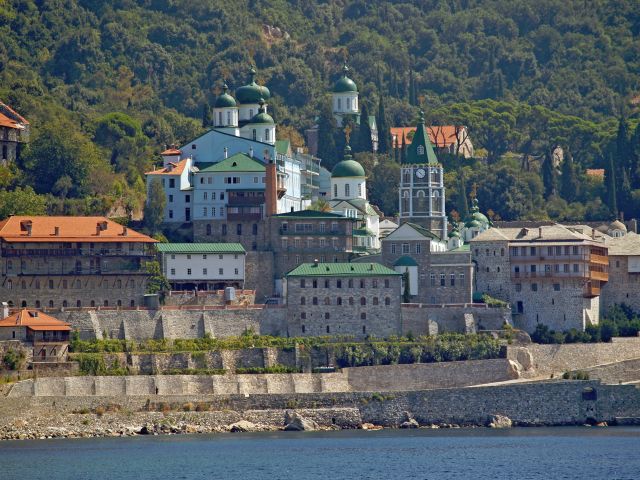
Agiou Panteleimonos
The monastery, also known as "Rossikon" (Russian monastery), was founded by the monk Leontios. According to current sources, this was at the end of the 10th century, although here and there the year 1030 is also mentioned.
The names of various abbots from the 11th century come from old documents. Why the monastery was abandoned and decayed in the 12th century is unknown. However, Russian monks, who had been living on Athos since the 11th century, were awarded the monastery in 1163. Until then they probably lived mainly in the “Xylurgou” monastery at the time.
The Russian monks with their abbot Laurentios were commissioned to rebuild the Panteleimonos monastery. Even today, the monastery still houses the document of the then Protos Ioannes, which regulated this and which is signed by the other 27 abbots at the time. Subsequently, Panteleimonos became the most important monastery of the Russians, while Xylurgou lost this claim.
In 1309, the monastery was burned to the ground by Catalan mercenaries. During the reconstruction, the Byzantine emperor Andronikos II Palaiologos (1282-1328) renewed the privileges of the monastery. In the 14th and 15th centuries, it was supported by Serbian and Romanian princes. In the 16th century, Russian tsars were generous patrons of the monastery.
Due to the political differences between Russia and Turkey, the Russian monks gave up their monastery in 1735. This was the end of the history of the monastery at its original place of foundation, which was almost two kilometers northeast in the interior of the peninsula than its present location. The ruins of that former monastery still exist today. Greek monks began rebuilding the monastery in 1765 where it is today.
From this point on, the monastery flourished. The facility was expanded to such an extent that today it almost looks like a small town.
At the end of the 19th century, there were around 1,500 monks, and at the beginning of the 20th century, there were over 1,900. The monastery was also visited by up to 25,000 Russian pilgrims a year at the turn of the 19th century. It was once one of the richest monasteries on Mount Athos, as it received financial support from Russia. However, this changed with the Russian October Revolution in 1917.
From then on, the monastery no longer received any money from Russia and its properties in Russia and Georgia were also confiscated. This almost meant the end of the history of the monastery. But somehow the remaining monks managed to keep their monastery.
In the meantime, the monastery has again received an influx of Russian monks, but this is limited by the Greek government. In 1968, a fire also destroyed part of the building complex. Most of the damage was repaired, however.
The most impressive property of the monastery is the icon of St. Panteleimonos (to whom it is also dedicated), part of the iconostasis of the monastery church, completely covered with gold.
The Skite Bogorodica is subordinate to the monastery.
Monastery Konstamonitou
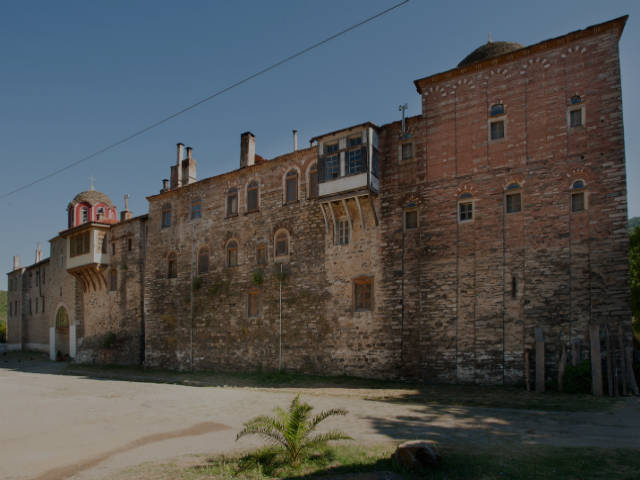
Konstamonitou
The foundation of the monastery, dedicated to St. Stefan, seems to have been in the 10th century. The first written record comes from the year 1051.
Nothing more is known about the history of the monastery in the following centuries, since hardly any documents can be found. In any case, it was inhabited by Greek monks until the 14th century it only played a minor role among the monasteries of the Holy Mountain. In the 1420s, a fire raged in the monastery.
Afterward, it was rebuilt by money and workers from a Serbian military leader. In the period that followed, it experienced an upswing that attracted numerous Slavic monks. However, less than 100 years later, at the beginning of the 16th century, the monastery was plagued by financial difficulties. When a fire broke out again in the middle of that century, it died down.
It was rebuilt by the Patriarch of Constantinople at the end of the 18th century. But financial worries were already pressing again in the middle of the 19th century. Disputes and trials with the neighboring Dochiariou monastery have been demonstrated in this regard. The monastery is also called Moni Kastamonitou. The name “Kastamonitou” comes from a tradition from the Middle Ages that sees a monk from Kastamone in Asia Minor as the founder.
Due to the constant ups and downs in the history of the monastery and the repeatedly experienced reconstructions and conversions, most of the buildings of today’s complex date from the 19th and 20th centuries.

